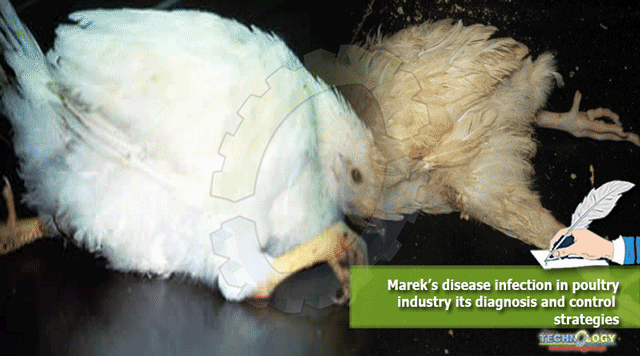Mareks disease is caused by Herpesvirus in chicken and occasionally in turkey. Whenever there is a Marek’s disease, there will be a tumour formation.

Author :Dr.Maria Jamil1, Dr.Kashif Saleemi1., Dr.Ali Raza2, Dr.Muhammad Tahir Aleem3
- Department of Pathology, Faculty of veterinary science, University of Agriculture, Faisalabad
- Department of Microbiology, Faculty of veterinary science, University of Agriculture, Faisalabad
- MOE Joint International Research Laboratory of Animal Health and Food Safety, College of Veterinary Medicine, Nanjing Agricultural University, 210095 Nanjing, P.R.China
\
Mareks disease is caused by Herpesvirus in chicken and occasionally in turkey. Whenever there is a Marek’s disease, there will be a tumour formation. This disease was first recognized in 1907 by Joseph Marek. It causes lymphocytic proliferation in liver, digestive and reproductive system also in nerves eyes and skin, can cause 10-50% morbidity and mortality reaches up to 100%. It can cause the unilateral paralyses of peripheral nerves such as sciatic, brachial and cervical nerves. The virus introduced into the body orally then incubates 3-4 hours. Mareks disease usually occurs 8 weeks of age, if bird exposed to the virus during the first week of age but still to develop tumour at 8-9 week of age.
Herpes virus is an oncogenic cell-associated virus; it multiplies in normal condition within the cell and calls it alpha herpes virus. It has 3 serotypes.
Serotype 1: contain an oncogenic virus and found everywhere—that why birds have the maximum chance to get this infection.
Serotype11: it is non-oncogenic mean not produce a tumour. So it can be used as a vaccine.
Serotype111: it does not infect chicken. Actually, it was isolated from turkey and call it herpesvirus of turkey. It also used as a vaccine for chicken.
Transmission:
- Mareks disease transmitted horizontally no vertical transmission.
- The virus is present in all body tissue and in feather follicular epithelium is the important mean to spread the virus.
- Darkling beetle also the virus, so use the safe insecticides.
Clinical signs:
- Paralysis of legs, wings and neck
- Weight loss
- Irregular pupil and grey iris
- Impaired vision
- The skin around feather follicles roughed and raised
Post mortem lesions:
- In liver, kidney, spleen, heart, lung and skeletal muscle seen grey white foci of neoplastic tissue.
- Loss of striation and thickening of nerve trunks.
- Lymphocytic nodules are present on the skin
- Loss of pigmentation of iris and irregular pupil
Microscopically: lymphoid infiltration is polymorphic (in different developmental stages as it is small, medium, and large, plasma cells and macrophages). By this pleomorphic feature, we can easily differentiate the Marek’s disease from lymphoid leucosis because in which homogenous infiltration of lymphocytes occurs.
Diagnosis:
Mareks disease diagnosed based on history, clinical sign, distribution of lesions, age and histopathology.
Differential diagnosis:
Lymphoid leucosis, deficiency of Ca/phosphorous/Vitamin D/thiamine and botulism.
Prevention:
- Hygiene
- All-in/all-out production
- Resistant strains
- The virus survives at ambient temperature for a longer period, i.e. 65 weeks and resistant to some disinfectant such as quaternary ammonium chloride and phenol but it can be inactivated frequently by frozen and thaw.
Vaccination:
Vaccination generally with 1500 PFU of HVT at day old in ovo application, association with other strains (SB1 serotype 2) and Rispens.
